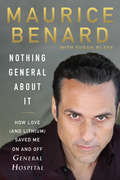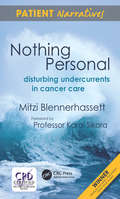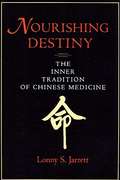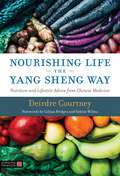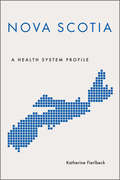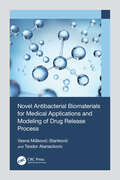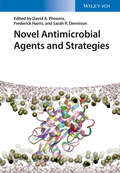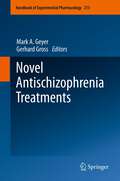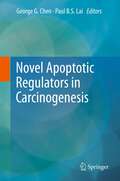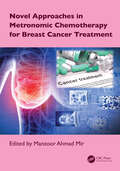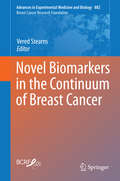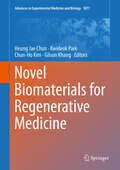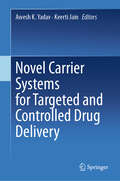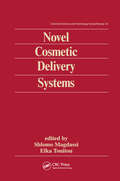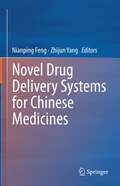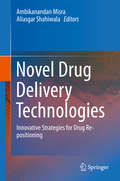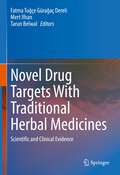- Table View
- List View
Nothing General About It: How Love (and Lithium) Saved Me On and Off General Hospital
by Maurice Benard Susan BlackThe General Hospital star recounts his emotional journey in this instant bestseller, a story of success, show business, family, and mental health.New York Times–bestselling author and Emmy Award–winning actor Maurice Benard is best known for his twenty-five years of playing Michael “Sonny” Corinthos, Jr., on ABC’s hit daytime television show General Hospital. The rakish mobster is beloved and feared, perhaps in equal measure, but what many viewers don’t know is that for decades, Benard lived in true fear of a much greater threat: himself.In Nothing General About It, Benard relays the challenges of growing up in a small town with undiagnosed bipolar disorder, and his struggle to keep his demons at bay while pursuing a career as an actor. From childhood to the outset of his career—and while building his family—he was pushed to the very boundaries of despair, struggling with the stigma of having a mental illness he felt he couldn’t share with the world. In his first memoir, Benard delves into the most challenging parts of his life, including his tenuous childhood relationship with his father, secretly managing manic episodes on the set of General Hospital, and fending off the terrifying setbacks he experienced when he went off his meds.An advocate for mental health awareness, Benard now uses his platform to show all those who are struggling that there is light to be found. Nothing General About It is more than a story of adversity—it’s a love story, a case study in perseverance and candor, and a reminder that bravery is achieved by embracing who you truly are.
Nothing Personal: Disturbing Undercurrents in Cancer Care (Radcliffe Ser.)
by Mitzi BlennerhassettThis is a remarkable book. It is the story of just one person but it is repeated time and time again by many, all over the world. She has a complex but potentially curable cancer from the outset - one that requires a surgical intervention, radiotherapy and chemotherapy to treat optimally. So Mitzi experiences everything. With a young and very active family to look after, she has a lot to live for so how she deals with uncertainty is fascinating. The disruption to her life by the cancer and its treatment is massive and to add to it all she is going through a marital breakdown at the same time.I feel it's an incredible privilege to be allowed to follow her journey so closely. 'This is essential reading for all who deal with cancer patients - health professionals, politicians, health service developers, carers and, of course, patients themselves. It clearly gives us a distillation of what cancer patients want. We need to create a new network of modern cancer centres where the latest technology in radiotherapy and chemotherapy is seamlessly delivered in a comfortable, welcoming environment. Novel information technology can be used to link the centres so every patient will be monitored to get the best possible treatment.'
Nothing Personal: Medical Thriller
by Eileen Dreyer"Action-packed, thoughtful, suspenseful, sensitive, all at the same time and all the way through." ~Ken Keith, Verified Reviewer Trauma nurse Kate Manion is viewing her own hospital from the other side. Badly injured in an auto accident, she's laying in her own ICU, strapped down, paralyzed and unconscious. And yet, somehow, she managed to kill her nurse.The murder was an accident; Kate swears. But the accidental deaths keep happening. Has someone taken Kate's mishap as a mandate to kill off anyone making life difficult for the staff?As corpses pile up, Kate realizes that only she can stop the serial killer who is acting out the fantasy of every staff member at St. Simon's Hospital.With only a burned-out forensic pathologist to help her, Kate must wade through greed, politics, secrets and suspicion to unearth a murderer she doesn't want to find; before he – or she—strikes too close to home.Publisher's Note: As a former trauma nurse, Eileen Dreyer combines her real-world medical knowledge and superb story-telling to bring readers a series of uniquely plotted, spine-tingling, medical mysteries. Fans of Tami Hoag, Elizabeth George, Nora Roberts as well as John Lutz, Michael Crichton and Patricia Cornwell will enjoy these well-crafted medical thrillers. OTHER MEDICAL SUSPENSE/THRILLERS by Eileen Dreyer:Nothing PersonalBrain DeadBad MedicineIf Looks Could Kill
Nourishing Destiny: The Inner Tradition of Chinese Medicine
by Lonny S. JarrettNourishing Destiny examines Chinese medicine as a science pertaining to the evolution of consciousness. Equating health with open awareness and illness with habitual functioning, He examines the Chinese notion of destiny as it applies to the practice of acupuncture and herbal medicine.
Nourishing Life the Yang Sheng Way: Nutrition and Lifestyle Advice from Chinese Medicine
by Deirdre CourtneyCombining the wisdom of classical Chinese medicine with modern nutritional science, this book explores the concept of Yang Sheng, which means to nourish life by nurturing body, mind and spirit in harmony with the natural rhythms and universal laws, revealing the importance of nutrition within it and outlining how our modern lifestyle and environment challenges our ability to do that. A perfect guide for practitioners and students of Chinese medicine, the book explains modern diets and Chinese nutritional theory with a focus on prevention of illness and the impact of lifestyle and environment on our health during each stage of life. Lifestyle and nutritional advice for prevention and treatment of a range of illnesses and conditions is given for both adults and children.
Nourishing Traditions: The Cookbook That Challenges Politically Correct Nutrition and the Diet Dictocrats (Revised 2nd Edition)
by Sally Fallon Mary Q EnigRecalling the culinary customs of our ancestors and looking ahead to a future of robust good health for young and old, Nourishing Traditions offers modern families a fascinating guide to wise food choices and proper preparation techniques. Nutrition researcher Sally Fallon unites the wisdom of the ancients with the latest independent and accurate scientific research. The revised and updated Second Edition contains over 700 delicious recipes that will please both exacting gourmets and busy parents. Book jacket.
Nova Scotia: A Health System Profile (Provincial and Territorial Health System Profiles)
by Katherine FierlbeckDespite notable variation in health care policy from province to province, most scholarship published on the health care system in Canada uses a broad national perspective. Focusing on the health care systems of individual Canadian provinces and territories, our new series, Health System Profiles, examines the social, political, economic, and epidemiological context of health care policy in each Canadian province. Turning a critical eye to the health care system in Nova Scotia, author Katherine Fierlbeck outlines the organizational and regulatory frameworks structuring provincial health care, while providing a detailed assessment of Nova Scotia’s health financing, physical infrastructure, service provision, and the efficacy of technological resources used in data tracking and health quality assessments. Structured for ease of comparison, Nova Scotia: A Health System Profile will, along with other volumes in the series, help scholars draw analytic evidence-based policy conclusions about the health system of Nova Scotia and other Canadian provinces and territories.
Novel (Trans)dermal Drug Delivery Strategies
by Hazel Garvie-CookThis work represents an inventive attempt to apply recent advances in nanotechnology to identify and characterise novel polymer systems for drug delivery through the skin. Atomic force microscopy (AFM) measurements of the nanoscale mechanical properties of topical, drug-containing polymeric films enabled the author to identify optimal compositions, in terms of flexibility and substantivity, for application to the skin. To elucidate the enhanced drug release from polyacrylate films incorporating medium chain triglycerides, the author combined AFM studies with the complementary technique of Raman micro-spectroscopy. This experimental strategy revealed that the significant increase in the drug released from these films is the result of a nanoscale two-phase structure. Finally, in experiments examining the microporation of skin using femtosecond laser ablation, the author demonstrated that the threshold at which the skin's barrier function is undermined can be dramatically reduced by the pre-application of ink. The approach allows thermal damage at the pore edge to be minimised, suggesting a very real potential for substantially increasing drug delivery in a minimally invasive fashion.
Novel Antibacterial Biomaterials for Medical Applications and Modeling of Drug Release Process
by Vesna Mišković-Stanković Teodor AtanackovicThis book provides a comprehensive review of synthesis and physicochemical and biological characterization of novel antibacterial biomaterials produced according to original procedures and aimed at medical applications such as wound dressing, soft and hard tissue implants, drug delivery devices, and carriers for cell cultivation. It is intended for all researchers working in the fields of biomaterials and biomedical engineering, as well as medical professionals, science and engineering graduate students, academics, and industrial researchers. Includes in-depth discussions on synthesis and physicochemical characterization of novel poly vinyl alcohol-based hydrogels aimed at wound dressings and soft tissue implants Explores synthesis and physicochemical characterization of novel bioceramic hydroxyapatite-based coatings on metal surface aimed for hard tissue implants Reviews cytotoxicity and antibacterial activity of novel poly vinyl alcohol-based hydrogels aimed for wound dressing and soft tissue implants Discusses cytotoxicity and antibacterial activity of bioceramic hydroxyapatite-based coatings on metal surface aimed for hard tissue implants Provides original fractional derivative models of drug release process from hydrogels and bioceramic coatings on metal surface and explores diffusion mechanism
Novel Anticancer Drug Protocols
by Alex A. Adjei John K. BuolamwiniThis book not only surveys the whole arena of novel anticancer drug targets, but also presents a wide-ranging selection of cutting-edge techniques currently being applied throughout novel antitumor drug discovery and development. The methods are applied to experiments involving such topics as immunotherapy, angiogenesis, cancer metastasis, the cell cycle, signal transduction inhibitors, apoptosis, antibodies, antisense molecules, microarray gene expression, flow cytometry, and PET imaging for cancer target validation. There are also proven methods for the preclinical identification of drug targets and for target validation during the clinical trials of novel agents.
Novel Antimicrobial Agents and Strategies
by David A. Phoenix Frederick Harris Sarah R. DennisonBy integrating knowledge from pharmacology, microbiology, molecular medicine, and engineering, researchers from Europe, the U.S. and Asia cover a broad spectrum of current and potential antimicrobial medications and treatments. The result is a comprehensive survey ranging from small-molecule antibiotics to antimicrobial peptides and their engineered mimetics, from enzymes to nucleic acid therapeutics, from metallic nanoparticles to photo- and sonosensitizers and to phage therapy. In each case, the therapeutic approaches are compared in terms of their mechanisms, likelihood to induce resistance, and their efficiency in a global healthcare context.Unrivaled knowledge for professionals in fundamental research, pharmaceutical development and clinical practice.
Novel Antischizophrenia Treatments
by Gerhard Gross Mark A. GeyerThis volume tries to put current therapy - achievements, shortcomings, remaining medical needs - and emerging new targets into the context of increasing knowledge regarding the genetic and neurodevelopmental contributions to the pathophysiology of schizophrenia. Some of the chapters also deal with respective experimental and clinical methodology, biomarkers, and translational aspects of drug development. The volume concentrates on reviewing the ongoing research attempting to identify novel treatments for the cognitive deficits and negative symptoms of schizophrenia, which are not treated adequately by current antipsychotic medications.
Novel Apoptotic Regulators in Carcinogenesis
by Paul B.S. Lai George G. ChenOur recent understanding of the cellular and molecular defects and the regulation of the apoptotic signalling pathways has resulted in rationally designed anticancer strategies and the development of novel agents that regulates apoptosis. A comprehensive review of all apoptotic-related anticancer therapies is not the purpose of this book. However, in the volume of this book with 11 chapters, we have described a number of novel apoptotic regulators that have shown promising value and also great feasibility for cancer treatment. These novel agents either occur naturally or are chemically synthesized. While we are excited about the discovery and development of these novel apoptotic regulators as potential anticancer agents, a degree of caution should be always borne in mind when interpreting the success of preclinical pro-apoptotic candidates since potential problems inevitably lie ahead. These problems usually include target specificity, unanticipated toxicity, compound stability, formulation issues, pharmacokinetic and pharmacodynamic profiles. Nevertheless, we believe that this collection of 11 chapters by established leaders in the area of apoptosis will be of great interest to not only academics working in the field of cancer research and apoptosis but also pharmaceutical and pharmacological industries that . We are looking forward to the further development to push these potential agents toward clinical stage.
Novel Approaches in Cancer Treatment: Tumor Targeted Therapy (Handbook of Cancer and Immunology #8)
by Nima RezaeiThe rapid flow of studies in the field of cancer and immunology during the last decades has increased our understanding of the interactions between the immune system and cancerous cells. In particular, it has been well-known that such interactions result in the induction of epigenetic changes in cancerous cells and the selection of less immunogenic clones as well as alterations in immune responses. Understanding the crosstalk between nascent transformed cells and cells of the immune system has led to the development of combinatorial immunotherapeutic strategies to combat cancer. The Handbook of Cancer and Immunology offers a comprehensive and up-to-date review of cancer immunology and immunotherapy, emphasizing key findings and clinically relevant data. This reference work is an essential resource for researchers, students, academics, and clinicians committed to advancing knowledge, diagnostics, and treatments in this vital field.
Novel Approaches in Metronomic Chemotherapy for Breast Cancer Treatment
by Manzoor Ahmad MirThis book provides the latest research and developments in the field of metronomic chemotherapy for breast cancer. It presents the principles and mechanisms of metronomic chemotherapy, preclinical and clinical studies, and the latest developments in drug delivery systems and nanoformulations. The clinical pharmacology of metronomic chemotherapy, including pharmacokinetics, pharmacogenetics, pharmacoeconomics, and adverse drug reactions, are also examined.Key Features: Introduces metronomics therapy in the neoadjuvant and adjuvant treatment of breast cancer Explores the potential of metronomics in terms of personalized chemotherapy Present pharmacological bases of metronomic chemotherapy Covers the latest developments in drug delivery systems, nanotechnology, and nanoformulations Discusses antiangiogenic effects and the impact of metronomics on immunity This book is useful for students, researchers, oncologists, pharmacologists, and healthcare experts interested in understanding the clinical potential of metronomic chemotherapy in breast cancer.
Novel Biomarkers in the Continuum of Breast Cancer
by Vered StearnsThis volume provides a comprehensive review of established and novel biomarkers across the continuum of breast cancer. The volume covers topics related to breast cancer risk and prevention, prediction of response to today's standard therapies, and markers capable of influencing treatment decisions in the near future. Chapter authors combine their wide-ranging expertise to review the current status of the biomarker and to offer their individual perspectives on how biomarkers may be used in future treatments and research. Breast cancer continues to be the most common malignancy diagnosed in women in the Western world. While there are multiple treatment approaches for breast cancer, today more than ever we recognize that each tumor is unique. The challenge ahead is to consider how to best use validated and novel biomarkers to select the most appropriate treatment(s) for individual patients.
Novel Biomaterials for Regenerative Medicine (Advances in Experimental Medicine and Biology #1077)
by Heung Jae Chun Kwideok Park Chun-Ho Kim Gilson KhangThis book explores in depth a wide range of new biomaterials that hold great promise for applications in regenerative medicine. The opening two sections are devoted to biomaterials designed to direct stem cell fate and regulate signaling pathways. Diverse novel functional biomaterials, including injectable nanocomposite hydrogels, electrosprayed nanoparticles, and waterborne polyurethane-based materials, are then discussed. The fourth section focuses on inorganic biomaterials, such as nanobioceramics, hydroxyapatite, and titanium dioxide. Finally, up-to-date information is provided on a wide range of smart natural biomaterials, ranging from silk fibroin-based scaffolds and collagen type I to chitosan, mussel-inspired biomaterials, and natural polymeric scaffolds. This is one of two books to be based on contributions from leading experts that were delivered at the 2018 Asia University Symposium on Biomedical Engineering in Seoul, Korea – the companion book examines in depth the latest enabling technologies for regenerative medicine.
Novel Carrier Systems for Targeted and Controlled Drug Delivery
by Keerti Jain Awesh K. YadavThe book presents novel carrier systems for the targeted and controlled drug delivery for the treatment of various diseases which are difficult to be treated with conventional drug delivery systems like cancer, autoimmune disorders, and emerging infectious diseases. It also reviews the origins and applications of stimuli-responsive polymer systems and polymer therapeutics such as polymer-protein and polymer-drug conjugates. The book also explores the potential applications of the parenteral route of administration for the delivery of active pharmaceutical substances with a narrow therapeutic index and poor bioavailability. Further, the book presents common routes of administration for the systemic delivery of peptides and proteins. It also examines the applications of various implantable systems in drug delivery. The book also covers the important colloidal drug delivery systems, including liposomes and niosomes and solid lipid nanoparticles, and nanostructured lipid carriers. Towards,the end, the book discusses the therapeutic potential of biodegradable polymeric nanoparticles for controlled drug delivery. Authoritative and thorough, this book is a valuable resource for researchers working on a multidisciplinary approach to employing drug delivery systems.
Novel Coronavirus 2019: In-silico Vaccine Design and Drug Discovery (SpringerBriefs in Applied Sciences and Technology)
by Amit Kumar G. Jyothsna Amita Kashyap Ajit Kumar Saxena Gwo Giun LeeThis book highlights the genomic findings, observations, and analysis of DNA/RNA sequences and protein structure of the dreadful virus of this decade- COVID-19. The Corona group of viruses though known species, the strain that caused the Pandemic of 2019 is a completely new strain, belonging to the same corona family with a novel genetic make-up. This makes it a new pathogen which is causing the current outbreak leaving the global scientific community clueless of any therapeutic breakthrough. NCOV enjoys life threatening pathogenicity with mysterious genetic annotations. This book details and offers insights into its viral genetic arrangement, Virulence factors, probable mutations leading to the evolution of this new strain and more. It contains chapters on Virus evolutionary status and Genetic makeup leading to its pathogenicity which can be a new insight in understanding the nature of this clever microorganism and can pave way to the development of new drugs and Vaccines or a novel diagnostic approach for the early prognosis of the disease. A dedicated chapter on annotation of NCOV-19 virulence genes, translation of the genes to protein product, annotation of the antigenic sites on these proteins is also included. In all, this brief is a complete genomic annotation insight of NCOV-19 using AI, Data analytics and Bioinformatics analysis. In the current situation, this book is an extensive preliminary resource for Medical practitioners, Researchers, Academicians, Scientists, Biochemists, Bioinformaticians and other professionals interested in understanding the genetics of Novel Coronavirus 19, the best possible drug targets, ideal vaccine candidates and novel prognostic and diagnostic biomarkers.
Novel Cosmetic Delivery Systems (Cosmetic Science And Technology Ser. #19)
by Shlomo Magdassi Elka Touitou"Highlights the uses of delivery systems in cosmetics, analyzing new approaches for obtaining sophisticated cosmetic products and examining the most common methods for enhancing the skin's penetration properties. Covers a wide range of established and burgeoning techniques."
Novel Developments in Stem Cell Mobilization
by W. Jens Zeller Stefan Fruehauf Gary CalandraRecently the CXCR4/CXCL12-axis has been recognized as one of the pivotal adhesion pathways by which hematopoietic stem cells are retained in the bone marrow. CXCR4 antagonists with different chemical specification are being developed. Pharmacology research guides the way to the rational development effective antagonists. One antagonist, plerixafor, is clinically approved now for stem cell mobilization of lymphoma and myeloma patients. This allows patients to receive potentially life-saving treatment which could not have been administered otherwise. Through early clinical studies it was recognized that CXCR4 antagonists also mobilize malignant hematopoetic cells, i.e. leukemia cells. In preclinical studies a sensitization of mobilized leukemic cells to standard cytotoxic chemotherapy could be shown. Clinical studies are under way. CXCR4 antagonists are an exciting new class of compounds which are also employed for the mobilization of angiogenic cells or for the treatment of solid tumors. In this book a concise review of the current status of knowledge and future developments will be presented.
Novel Drug Delivery Systems for Chinese Medicines
by Nianping Feng Zhijun YangThis book describes the essential and cutting-edge concepts based on the frontier of pharmaceutical research in TCM, underlying scientific principles, and current advancements of drug delivery systems for Chinese medicines, including sustained-release drug delivery systems, trans-nasal drug delivery systems, dermal and transdermal drug delivery systems, etc. Novel carriers and emerging technologies (such as 3D printing) are also covered. The book provides readers with an overall picture of drug delivery systems for Chinese medicines and also yields benefits for the pharmaceutical industry with regard to TCM-based drug development.
Novel Drug Delivery Systems for Phytoconstituents
by Madhu Gupta Durgesh Nandini Chauhan Vikas Sharma Nagendra Singh ChauhanNovel Drug Delivery Systems for Phytoconstituents discusses general principles of drug targeting, construction material and technological concerns of different phytoconstituent in delivery systems. It focuses on the development of novel herbal formulations and summarizes their method of preparation, type of active ingredients, route of administration, biological activity and their applications. It dicusses therapeutic activities of plant derived chemicals, their limitations in clinical applications and novel drug delivery solutions to overcome them to provide better therapeutic effects with controlled and targeted drug delivery. Focus on drug delivery of phytomolecules Act as bridge between natural product scientist and clinical doctors Discusses mechanism of poor bioavailability of herbal molecules Increases awareness towards phytochemical efficacy Summarizes efficient novel delivery systems-based formulations. It extensively covers the applications of novel drug delivery systems including polymeric nanoparticles, solid lipid nanoparticles, nanostructured lipid capsules, liposomes, phytosomes, microsphere, transferosomes, and ethosomes. Some chapters are especially focused on anticancer phytodrugs, silymarin, andrographolide, berberine, and curcumin delivery with special emphasis on their application.
Novel Drug Delivery Technologies: Innovative Strategies for Drug Re-positioning
by Ambikanandan Misra Aliasgar ShahiwalaThe application of drug delivery is a valuable, cost-effective lifecycle management resource. By endowing drugs with new and innovative therapeutic benefits, drug delivery systems extend products’ profitable lifecycle, giving pharmaceutical companies competitive and financial advantages, and providing patients with improved medications. Formulation development is now being used to create new dosage forms for existing products, which not only reduces the time and expense involved in new drug development, but also helps with regard to patent protection and bypassing existing patents. Today’s culture demands convenience, a major factor determining adherence to drug therapy. Over the past few years, patient convenience-oriented research in the field of drug delivery has yielded a range of innovative drug-delivery options. As a result, various drug-delivery systems, including medicated chewing gums, oral dispersible tablets, medicated lozenges and lollipops, have now hit the market and are very popular. These dosage forms offer a highly convenient way to dose medications, not only for special population groups with swallowing difficulties, such as children and the elderly, but for the general populace as well. This book provides valuable insights into a number of formulation design approaches that are currently being used, or could be used, to provide new benefits from existing drug molecules.
Novel Drug Targets With Traditional Herbal Medicines: Scientific and Clinical Evidence
by Tarun Belwal Fatma Tuğçe Gürağaç Dereli Mert IlhanThis book collects information about the most popular ethnomedicinal plants, which are common in Turkey and around the world. It presents the ethnopharmacological records, in vivo and in vitro studies, side effects, chemical compositions and clinical studies of these medicinal plants. Its special focus is on the novel drug targets for disease and their possible mechanisms of action. It covers botanical descriptions the status of the plants, and food or drug interactions including precautions and warnings about the plants and the available market products. It provides an explanation of recorded and known plant administration dosages. Also, the gap between the traditional practice and scientific/clinical evidences in the use of ethnomedicinal plant is acknowledged.It is well known that traditional knowledge of the use of the medicinal plants in therapy is an important resource for the discovery of novel treatment options and drug targets. The main purpose of this book is to draw attention to ethnomedicinal plant species. Data on the therapeutic potentials of these medicinal plants can now be accessed from a single source. It provides an important resource for future research opportunities for harnessing the full potential of these plants.
